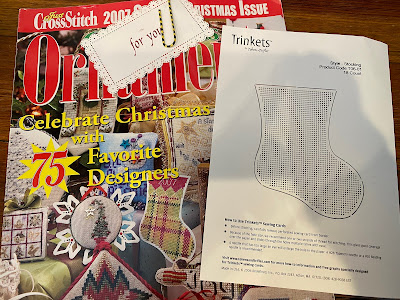If you are interested:
1) you have to send me an email (tricia@alum.mit.edu) with "Stocking" in the subject line.
2) You HAVE to put your name and full address in the body of the message (I can't send it to people who don't).
3) Then send by Midnight EST on Dec 25th
I will pick a winners to send them to after Christmas.
Have you seen the video on the making of the bottles for the embroidered caskets? Each of the current casket classes (Harmony with Nature, Four Seasons Double Casket and Five Senses Double Casket) includes the bottles needed to fill the cavities in the box for them. It took me about 10 years to reproduce the bottles and I think the process would be surprising to those who haven't ever done any manufacturing. I often get questions like "ever thought of bringing back Tokens and Trifles" or "can I make that at home" or other ones that show the writer isn't an avid watcher of the Science Channel show "How It's Made". We are in this house and setting up to make more than one of something - or make one at all - is really complex. So I made the video about the reproduction of the bottles to give a flavor of what it takes. Hint... complicated! You can watch the video by creating a free account on my teaching website (don't forget to look through the free projects there) and clicking on that free video.
This is really the reason why there will never be another casket course like the ones I have been doing (We are now down to about 86 total caskets not claimed between all the courses - then done). Once you see what went into just one item for the boxes - then think about how almost EVERYTHING about the boxes - has gone through that process. It all starts with a mini-research project about the item, say the paper used under the embroidery to act as both a barrier between the wood and the embroidery and aid the gluing of the embroidery to the wood. It is also used to cover all the raw exposed edges of the box. After making appointments to examine over 50 caskets (realize that most institutions or collectors own just one - so think about how many institutions I had to travel to!) to get a baseline on 'what does the paper look like and what is the variance', I then researched paper makers of the period, papers of the period, raw materials used, and why were all some shade of purple to grey.
From that I found scientific papers showing that the colors were all originally one color and that the differences were the amount of oxidation. This was backed up when looking at two caskets which had the original bright silver stamping on the dark purple paper still intact because the wood panel in front of it had warped and touched it so it kept the oxygen out. So all the paper had been purple. That then confirmed my suspicion that the paper was the 'blue paper' advertised in London in that period. Made of linen rags and mainly of one cheeper dye source, it was the butchers paper of the day. Used to wrap sugar cones and be the general packaging. It was used to glue onto caskets. From there, I had more information on the composition and I could then start looking for the few people who made fine handmade papers who could do this type of paper. Once I found the right person, we had to establish the color of purple, do tests making paper, try her wares gluing on wood and turning corners, etc. and then start production. Just for something that you likely think is 'just paper'. She has now, after an illness, gone into semi-retirement and is making paper to finish up my classes before she shutters her workshop.

No comments:
Post a Comment